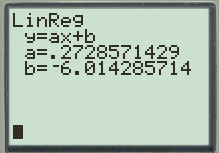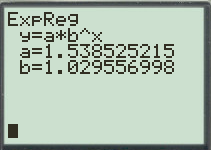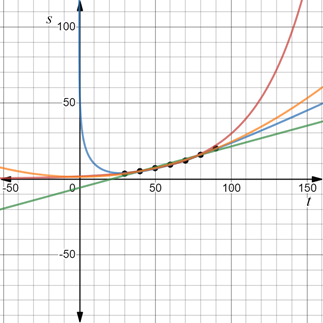
Concept explainers
a.
To calculate: The linear model
a.
Answer to Problem 60E
The linear model
Explanation of Solution
Given information:
The time measured in seconds required by a car to attain a speed measured in miles from a starting point is provided below,
Also, the above data can be modeled as,
Calculation:
Consider the time measured in seconds required by a car to attain a speed measured in miles from a starting point is provided below,
Follow the steps provided below to estimate the linear model.
Step 1: Press
Step 2: Press
Step 3: Enter the column 1 of table provided above in
Step 4: Enter the column 2 of table provided above in
Step 5: Press
Step 6: Press
Step 7: Select the fourth option that is
Step 8: Press
Step 9: Press
The result obtained on screen is provided below.

Therefore, linear model is,
Follow the steps provided below to estimate the exponential model.
Step 1: Press
Step 2: Press
Step 3: Enter the column 1 of table provided above in
Step 4: Enter the column 2 of table provided above in
Step 5: Press
Step 6: Press
Step 7: Select the fourth option that is
Step 8: Press
Step 9: Press
The result obtained on screen is provided below.

Therefore, exponential model is,
b.
To graph: The model that represent the data.
b.
Explanation of Solution
Given information:
The time measured in seconds required by a car to attain a speed measured in miles from a starting point is provided below,
Also, the above data can be modeled as,
Graph:
Consider the time measured in seconds required by a car to attain a speed measured in miles from a starting point is provided below,
Also, the above data can be modeled as,
The linear model
Plot the data points and all the models in the coordinate plane.

The green curve line represents
Interpretation:
All the models and the data points itself coincide with each other. All the models fits with the data.
c.
To calculate: The tabular estimation of the models for the data.
c.
Answer to Problem 60E
The estimation is provided below,
Explanation of Solution
Given information:
The time measured in seconds required by a car to attain a speed measured in miles from a starting point is provided below,
Also, the above data can be modeled as,
Calculation:
Consider the time measured in seconds required by a car to attain a speed measured in miles from a starting point is provided below,
The linear model
For each value of s compute the value of t for different models.
d.
To calculate: The sum of absolute values of differences between data and estimated values provided by each model. Also explain the model that best fits the data based on sums.
d.
Answer to Problem 60E
The sum is
Explanation of Solution
Given information:
The time measured in seconds required by a car to attain a speed measured in miles from a starting point is provided below,
Also, the above data can be modeled as,
Calculation:
Consider the time measured in seconds required by a car to attain a speed measured in miles from a starting point is provided below,
Also, the above data can be modeled as,
The linear model
For each value of s compute the value of t for different models.
Now, sum of absolute values of differences between data and estimated values provided by each model is,
For
For
For
For
The model that best fits the data is the one which has least sum of the absolute values of the differences between the estimated and actual data. This is represented by model
Thus, the sum is
Chapter 3 Solutions
EBK PRECALCULUS W/LIMITS
- Pls help ASAParrow_forward9. a) Determie values of a and b so that the function is continuous. ax - 2b f(x) 2 x≤-2 -2x+a, x ≥2 \-ax² - bx + 1, −2 < x < 2) 9b) Consider f(x): = 2x²+x-3 x-b and determine all the values of b such that f(x) does not have a vertical asymptote. Show work.arrow_forwardPls help ASAParrow_forward
- 3. True False. If false create functions that prove it is false. Note: f(x) = g(x). a) If_lim ƒ(x) = ∞ and_lim g(x) = ∞,then_lim [ƒ(x) − g(x)] = 0 x→ 0+ x→0+ x→0+ b) If h(x) and g(x) are continuous at x = c, and if h(c) > 0 and g(c) = 0, then h(x) lim. will = x→c g(x) c) If lim f(x) = 0 and lim g(x) = 0 then lim f(x) does not exist. x-a x-a x→a g(x)arrow_forwardPls help ASAParrow_forward15. a) Consider f(x) = x-1 3x+2 and use the difference quotient to determine the simplified expression in terms of x, for the slope of any tangent to y = f(x). Also, determine the slope at x = 2. 15 b) Determine the equation of the tangent to f(x) at x = 2. Final answer in Standard Form Ax + By + C = 0, A ≥ 0, with no fractions or decimals.arrow_forward
 Calculus: Early TranscendentalsCalculusISBN:9781285741550Author:James StewartPublisher:Cengage Learning
Calculus: Early TranscendentalsCalculusISBN:9781285741550Author:James StewartPublisher:Cengage Learning Thomas' Calculus (14th Edition)CalculusISBN:9780134438986Author:Joel R. Hass, Christopher E. Heil, Maurice D. WeirPublisher:PEARSON
Thomas' Calculus (14th Edition)CalculusISBN:9780134438986Author:Joel R. Hass, Christopher E. Heil, Maurice D. WeirPublisher:PEARSON Calculus: Early Transcendentals (3rd Edition)CalculusISBN:9780134763644Author:William L. Briggs, Lyle Cochran, Bernard Gillett, Eric SchulzPublisher:PEARSON
Calculus: Early Transcendentals (3rd Edition)CalculusISBN:9780134763644Author:William L. Briggs, Lyle Cochran, Bernard Gillett, Eric SchulzPublisher:PEARSON Calculus: Early TranscendentalsCalculusISBN:9781319050740Author:Jon Rogawski, Colin Adams, Robert FranzosaPublisher:W. H. Freeman
Calculus: Early TranscendentalsCalculusISBN:9781319050740Author:Jon Rogawski, Colin Adams, Robert FranzosaPublisher:W. H. Freeman
 Calculus: Early Transcendental FunctionsCalculusISBN:9781337552516Author:Ron Larson, Bruce H. EdwardsPublisher:Cengage Learning
Calculus: Early Transcendental FunctionsCalculusISBN:9781337552516Author:Ron Larson, Bruce H. EdwardsPublisher:Cengage Learning





